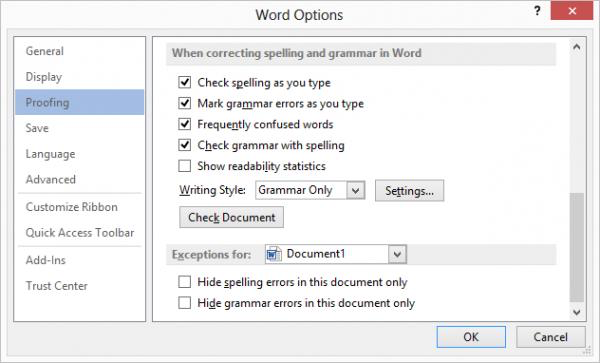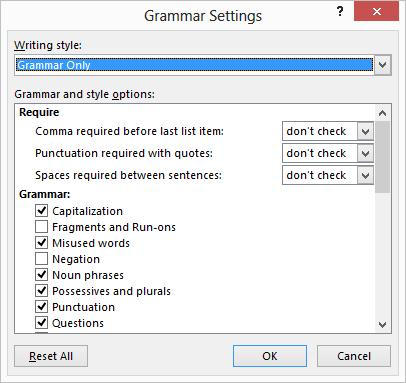Please Note: This article is written for users of the following Microsoft Word versions: 2007, 2010, 2013, and 2016. If you are using an earlier version (Word 2003 or earlier), this tip may not work for you. For a version of this tip written specifically for earlier versions of Word, click here: Changing How Word Flags Compound Words.
Written by Allen Wyatt (last updated August 18, 2022)
This tip applies to Word 2007, 2010, 2013, and 2016
Mark is having a problem with the spell checker and words that are connected with each other using a non-breaking hyphen. It seems that Word is flagging the words as incorrect, when it never flags them if the hyphen isn't there. Mark tried adding the words to the dictionary and tried telling Word to ignore the words, but they still get flagged.
There are two things to try. First, you can try these steps if you are using Word 2007, Word 2010, or Word 2013:

Figure 1. The Proofing options of the Word Options dialog box.

Figure 2. The Grammar Settings dialog box.
The above steps won't work in Word 2016 because the grammar and style options are greatly reduced in that version. You could, however, try the steps and turn off the Hyphenation option in step 5; that may work in some instances.
The other option is to try a workaround that some subscribers have reported as successful: Select the first word (the one before the hyphen) and add it to Word's exclusion list. (How you create and use exclusion lists has been examined in other issues of WordTips; doing a search for the phrase on the WordTips website will turn up several results.)
WordTips is your source for cost-effective Microsoft Word training. (Microsoft Word is the most popular word processing software in the world.) This tip (7351) applies to Microsoft Word 2007, 2010, 2013, and 2016. You can find a version of this tip for the older menu interface of Word here: Changing How Word Flags Compound Words.

Discover the Power of Microsoft Office This beginner-friendly guide reveals the expert tips and strategies you need to skyrocket your productivity and use Office 365 like a pro. Mastering software like Word, Excel, and PowerPoint is essential to be more efficient and advance your career. Simple lessons guide you through every step, providing the knowledge you need to get started. Check out Microsoft Office 365 For Beginners today!
Word's grammar checker dutifully tries to mark all the questionable grammar in your sentences. If you are tired of a ...
Discover MoreIf a word is normally supposed to be lowercase, Word helpfully lets you know if you incorrectly capitalize it. If you ...
Discover MoreWhile you are typing in a document, Word is typically busy checking what you type for errors. If an error is found, Word ...
Discover MoreFREE SERVICE: Get tips like this every week in WordTips, a free productivity newsletter. Enter your address and click "Subscribe."
There are currently no comments for this tip. (Be the first to leave your comment—just use the simple form above!)
Got a version of Word that uses the ribbon interface (Word 2007 or later)? This site is for you! If you use an earlier version of Word, visit our WordTips site focusing on the menu interface.
Visit the WordTips channel on YouTube
FREE SERVICE: Get tips like this every week in WordTips, a free productivity newsletter. Enter your address and click "Subscribe."
Copyright © 2025 Sharon Parq Associates, Inc.
Comments